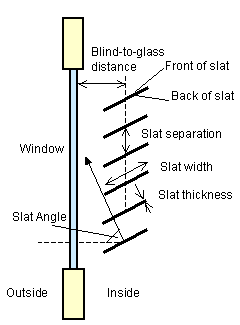Webinar: Design Stage Performance Modelling
Reliable and accurate modelling of in-use energy performance is increasingly required for sustainable building design. It can be achieved by following a structured performance modelling approach, such as those in CIBSE TM54, NABERS, or ASHRAE Standard 209. In this webinar, on 28th February, we will show you how to accurately evaluate operational energy use at the design stage in accordance with good practice modelling guidance. We will use TM54 as an example, which is similar to many other modelling guides used globally. The webinar will cover:
- Key principles of design stage performance modelling
- Step-by-step modelling process at early and advanced stages of building design
- CIBSE TM54:2022 specific guidance
You can register to either attend the live webinar on 28th February or to receive a recording of the webinar here.
Dynamic Thermal Modelling of Basic Blinds (TM69)
Modelling blinds correctly is important to understand their impact on building energy use for lighting, heating and cooling, and also on the visual and thermal comfort of occupants. CIBSE has recently published TM69: 2022, a new Technical Memorandum on “Dynamic Modelling of Basic Blinds”. The publication provides guidance on how to model basic single-layer internal blinds and related information. We were on the committee that developed this important publication, and DesignBuilder was used to model some of the scenarios that led to the conclusions and recommendations. As one of the most widely used tools for dynamic thermal modelling, DesignBuilder’s capabilities for modelling blinds are listed in Appendix F. In DesignBuilder, you can also model a much wider range of blinds than the basic single-layer shades covered in TM69, including Slatted blinds, Shades, Electrochromic switching and SageGlass electrochromic blinds. You can find more information on window blind modelling in DesignBuilder here. CIBSE is organising a launch event for TM69 on Tue, Feb 21, 2023, 11:00 AM – 12:00 AM GMT where a panel of experts will discuss the new guidance released. They will also be showing how you can model aspects of TM69 in DesignBuilder during the webinar. Register now to discover more about the latest knowledge technical memorandum and how it can be used in your work.

DesignBuilder Online International Courses
Building Energy and Environmental Simulation (Online)
- Seiscubos and the Instituto Superior de Arquitectura y Diseño have joined forces to offer a high-quality online course in Building Energy and Environmental Simulation delivered in Spanish. In addition to a theoretical module, the course includes a set of guided exercises using DesignBuilder. More than simply learning the software commands, the course provides guidance on how to develop a consistent and meaningful approach to analysis, which gives it a uniquely professional focus. If you are interested to learn more, you can find more information here.
DesignBuilder Australia Online Interactive Workshop
- DesignBuilder Australia is organising a two day online interactive workshop covering basic as well as advanced concepts in building simulation using DesignBuilder. If you are interested to learn more, you can find more information here.
Top Tip: Modelling Repeating Thermal Bridging in Simulations
Simulating the effect of repeating thermal bridges directly in EnergyPlus is not possible, but DesignBuilder offers a simple and effective workaround. You can approximate repeated bridging effects by adjusting the insulation thickness in the model so that the construction U-value matches the value calculated according to ISO 6946. Here’s a summary of how it’s done:
- Determine the U-value of the actual bridged construction using ISO 6946.
- Calculate the thickness of insulation required to achieve the same U-value using the Set U-value tool.
- Adjust the insulation thickness to match the calculated value.
The construction should now behave in a very similar way to the bridged construction in heating and cooling design calculations and in simulations. By following these steps, you can overcome the EnergyPlus limitations and easily approximate the effect of repeat thermal bridging in your DesignBuilder simulation results.NB: Adjusting the insulation thickness may change your zone areas and volumes, depending on which “Geometry convention template” you are using. That could change results for calculations on a per area/volume basis (lighting, HVAC loads and energy etc.), so you should always consider that when changing the insulation thickness. This might be particularly important in optimisation studies for example.
